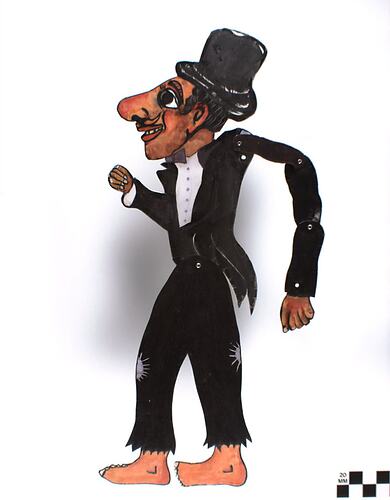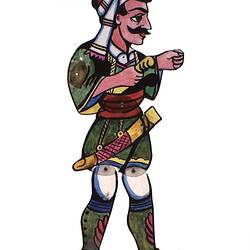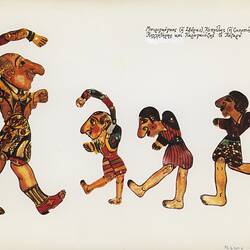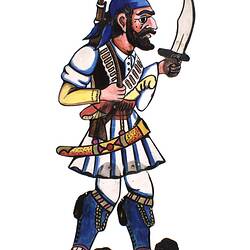Summary
This puppet was made in 1978 by Dimitri Katsoulis at his home in Port Melbourne. and used by him in performances in Victoria and in South Australia from 1978 to 1991. Dimitri Katsoulis migrated to Australia in 1974 to escape a regime that repressed Greek artists. He had trained in Greece with theatre and film companies as an actor and technician. A master of the traditional Greek shadow puppet theatre, his performances explored contemporary issues such as the isolation of migrant women and children. Unable to obtain funding and support, he returned to Greece in 1991, leaving his entire collection to the people of Victoria. It includes 32 shadow puppets and around 170 props, set backdrops and technical tools and stage equipment. Dimitri has since returned to Melbourne and assists the Museum to continue to document this rich art form within both local and international contexts.
Karaghiozis is a character in the centuries-old Greek Shadow Puppet Theatre (Karaghiozis) tradition. Karaghiozis identifies with the common man with all the advantages and faults. The Greek Karaghiozis is wiser and less of a clown than Karagoz, his Turkish brother. He is poor and uneducated, relying on his cunning and ready wit to extricate himself from precarious situations. He is a Greek folk hero for children and adults. Karaghiozis often mocks the various characters and includes them in his desperate adventures. He also pays them shameless compliments in order to avoid being harassed. Although totally uneducated, Karaghiozis manages to bluff his way into different jobs, allowing the puppeteer to satirise prominent figures, professions and contemporary issues. His principle characteristic is his sarcastic and satirical disposition. He does not accept charity and mocks himself, he is unemployed but concocts various means to make ends meet for his family. He is cunning, extremely intelligent, witty, just and honest and he does not seek to avoid the responsibilities with which he is charged. He is a small time swindler.
In this attire, he appears in comedies such as 'Karaghiozis the Mayor', 'Karaghiozis, Member of Parliament', 'Karaghiozis the Doctor', etc. In the play 'Karaghiozis the Doctor', he is summoned by the Pasha [a state ranking political advisor] to go to Sarai to cure the daughter of the Vizier (the Veziris - originally a Persian term for a high-ranking political, and sometimes religious, advisor or minister, often to a Muslim monarch such as a Sultan). She has lost her voice and appears to be at death's door. He denies that he is a doctor, however the Pasha insists and in the end he orders the soldiers who are accompanying him to beat him. In order to avoid the beating, he is forced to admit that he is a doctor, he goes to Sarai, he examines the girl and finds that she has been faking illness because her father doesn't approve of the man that she is in love with. Karaghiozis then decides to intervene by creating a ruse to trick the Vizier (the Veziris). He tells him that in his professional opinion, the only way that his daughter can be cured is for her to marry Selim. The Vizier (the Veziris) accepts this in order to save his daughter and agrees to the marriage.
The puppet is manipulated by two puppet rods [there are many examples in the collection], one which is connected to the puppet's shoulder and the other on its hand, to make it move on the stage. Karaghiozis has one abnormally long arm so that his gestures can have additional expressiveness.
Information supplied by Greek Shadow Puppet Theatre master Dimitri Katsoulis, 2007.
Physical Description
A two-dimensional figure of a man, in profile, jointed at waist, shoulder and two places in the arm. There is one leather extension in the arm. The man is dressed in a black suit with ragged trousers, tail-coat and bowler hat. His feet are bare. There is a hole in the shoulder where the supporting rod should be attached, and another in one wrist.
Significance
This collection of puppets, props, stage sets, and technical tools and equipment relating to traditional Greek Shadow Puppet Theatre is unique in Australia and rare in international public collections. The history of Greek Shadow Puppet Theatre, its puppet characters and the methodology of its performance has been recorded in partnership with the puppet master to whom the collection belonged. The collection is highly significant both as documentation of an important cross-cultural, centuries-old art form, and as an example of the transnational migration of cultural activity between Greece and Australia. It is a collection which was created and performed in Greece and Australia from the mid to late twentieth century, by two puppet masters, who transported the tradition between two countries. Abraam Antonakos came to Australia in 1977 to perform the puppet theatre and then deposited the puppets with Dimitri Katsoulis, who had migrated to Australia in 1974. Dimitri's story becomes one of migration experience, cultural maintenance and adaptation, and finally return migration and the discontinuance of this cultural art form in Australia.
More Information
-
Collection Names
-
Collecting Areas
-
Acquisition Information
Purchase
-
Artist
-
User
-
User
Mr Abraam Antonakos, Victoria, Australia, 1977
Abraam made the puppet in Greece, and used it in performances during the 1960s and 1970s; and then in Victoria in 1977. -
User
Mr Dimitri Katsoulis, Australia, 1978-1991
Dimitri was given the puppet by Abraam in 1977 and then used it in his performances in Australia until 1991. -
Classification
-
Category
-
Discipline
-
Type of item
-
Overall Dimensions
21 cm (Length), 66.5 cm (Height)
-
Exhibition Collection Management
660 mm (Length), 300 mm (Width)
as mounted
-
References
[Link 1] Malkin, Michael, R. Traditional and Folk Puppets of the World, A.S. Barnes & Co., Inc., N.J., 1977; Simmen, Rene, The World of Puppets, Elsevier, Phaidon, London, 1975; Hogarth, Ann & Bussell, Jan, Fanfare for Puppets!, David & Charles Publishers Ltd, USA, 1985; Yayannos, A & Ar and Dingli, J. The World of Karaghiozis, 1976
-
Keywords
Cultural Maintenance, Greek Communities, Greek Immigration, Karaghiozis Theatre, Shadow Puppetry, Theatres, Working Life



